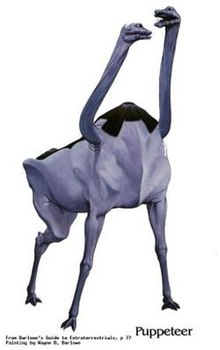 Ringworld is Larry Niven's 1970 science-fiction classic, a tale that has launched a graphic novel series and over a dozen and a half sequels and prequels. I am reviewing the original Ringworld. Set nearly 900 years in the future, Ringworld is at its heart the story of four explorers: Louis Wu, a 200-year-old human man who is indistinguishable from a 30-year-old man; Nessus, a "Puppeteer" with two heads and from a race of highly-developed xenophobes; Speaker-to-Animal, a Kzin who belongs to a race of large, warlike cat creatures; and finally Teela, a 20-year-old human woman born of insurmountable luck. Nessus brings them together on a quest to study a strange ring-shaped planet, built around a sun like Earth's, with the diameter of Earth's orbit using a ship with an advanced hyper-drive. They quickly crash and find out that the giant world has reverted to savagery.
Ringworld is Larry Niven's 1970 science-fiction classic, a tale that has launched a graphic novel series and over a dozen and a half sequels and prequels. I am reviewing the original Ringworld. Set nearly 900 years in the future, Ringworld is at its heart the story of four explorers: Louis Wu, a 200-year-old human man who is indistinguishable from a 30-year-old man; Nessus, a "Puppeteer" with two heads and from a race of highly-developed xenophobes; Speaker-to-Animal, a Kzin who belongs to a race of large, warlike cat creatures; and finally Teela, a 20-year-old human woman born of insurmountable luck. Nessus brings them together on a quest to study a strange ring-shaped planet, built around a sun like Earth's, with the diameter of Earth's orbit using a ship with an advanced hyper-drive. They quickly crash and find out that the giant world has reverted to savagery.
What makes this novel successful and what helped it spawn nine sequels and a pair of graphic novels is how complete the universe in which Ringworld takes place is. The Puppeteers are a very powerful race, but they fear contact with all outsiders. In fact, because Nessus isn't as afraid as everyone else, he is thought to be insane. He upholds this thought, saying, "the majority is always sane." The Kzin attacked the humans after the humans were at peace for 200 years, and the Kzin are warlike and honorable, reminiscent of the Klingons in Star Trek: The Next Generation and beyond. There are other races as well, including the unseen Ringworld Engineers, who are viewed as gods by the primitive people of Ringworld.
I had a lot of fun reading this novel, which is driven by its characters. The Pierson's Puppeteers and the Kzin are interesting alien species, and their respective traits drive the series, which I hope to read more of in the future.
No comments:
Post a Comment